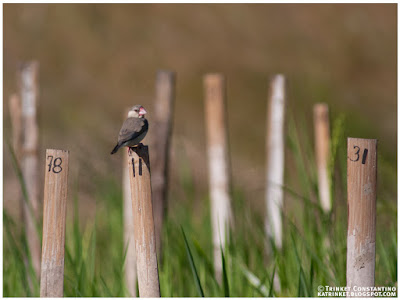I was happy to see large flocks (around 50 birds) of Java Sparrows in the fields. Introduced in the country as caged birds, feral populations have established themselves all over, although I have not observed them in numbers as large as the native Chestnut, Scaly-breasted and White-bellied Munias.
 |
| The introduced Java Sparrow has such a smart plumage pattern. |
I love the distinctive markings of these birds, no doubt it's what makes them popular in the pet trade. There were several juvenile birds flocking together in the fields, and a few adults mixed in with the Chestnut Munias.
 |
| Contestant # 11: a bit under age? |
 |
| Young Java Sparrows flocking together. |
The rice planted in the fields was very young and green, and a lot of the muddy ground was still exposed. We also saw a lot of waders - mostly migrant Wood Sandpipers and resident Little Ringed Plovers.
We observed a resident Collared Kingfisher pick up what looked like a mole cricket nypmh from the muddy ground. It flew up to the eelctrical wires and proceeded to swallow, regurgitate, re-position and then swallow again, the unfortunate prey.
 |
| The resident Collared Kingfisher enjoying a tasty meal. |
It was cool to see the nictitating membrane cover its eye anytime it attempted to swallow its food. The translucent "third eyelid" gave it a creepy zombie-bird look.
At the dairy farms, we wanted to check out the endemic Spotted Buttonquails. At the end of the day, the foot (and pedicab) traffic on the dirt roads was quite heavy, so we weren't sure if we would see any ground birds. Still, we set-up the scope and proceeded to greet everyone passing us on the trail. And then, just as the last light of day began to fade, we noticed 2 buttonquails taking dust bath quite a distance away.
A look through the scope confirmed that they were indeed the target endemics!
An endemic Spotted Buttonquail enjoying a dustbath. (Quite a distance away even through the scope, watch in HD)
They quickly scurried off the path though, to make way for two exuberant young boys, running home from school. As the sun set on a full day of forest and field birding, we decided we best be on our way home as well.
 |
| It's time to go home. |









































